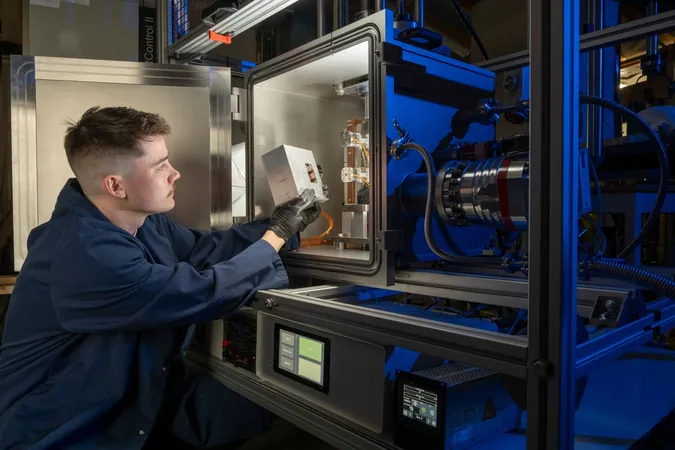
Revolutionizing Space Manufacturing: The University of Glasgow's Groundbreaking 3D Printing Lab
2025-05-14
Author: Li
Pioneering Space Innovation at the University of Glasgow
Researchers at the University of Glasgow have unveiled a game-changing facility—**the NextSpace Testrig**, touted as the world’s first testing lab dedicated exclusively to materials meant for 3D printing in orbit. This groundbreaking platform is set to transform the evolving domain of space manufacturing by guaranteeing that components created in the vastness of space are structurally robust and safe.
Why 3D Printing in Space is a Game Changer
As both space agencies and private enterprises shift their focus to constructing infrastructures in orbit, the importance of rigorously testing and validating 3D-printed materials has skyrocketed. The **NextSpace Testrig** finally bridges the gap between innovation and practical application, bringing this vital capability to Earth.
Funded for the Future
Supported by a generous **£253,000 grant** from the UK Space Agency’s Enabling Technology Programme, Dr. Gilles Bailet and his team at the University of Glasgow, in collaboration with The Manufacturing Technology Centre, are driving this ambitious project forward. Dr. Bailet emphasizes the enormous potential of this technology for complex, in-orbit construction.
Rethinking Space Missions
Traditional space missions hinge on launching complete equipment, a costly endeavor limited by the size of rockets. In contrast, space manufacturing—leveraging specialized 3D printers—enables the assembly of intricate components directly in space, from solar reflectors to spacecraft parts, drastically cutting costs and logistical burdens.
Confronting the Space Junk Crisis
One critical concern when it comes to in-space 3D printing is the risk associated with structural failures. Even minor flaws can lead to catastrophic failures in orbit, where small debris can travel at incredible speeds, posing significant threats to satellites and human life. The **NextSpace Testrig** emerges as a crucial tool to mitigate these risks, providing essential data on how 3D-printed materials perform in conditions that mimic space.
Creating a Space-Like Environment on Earth
At the heart of the facility lies a custom vacuum chamber that replicates the harsh conditions of space, with temperatures ranging from **-150°C to +250°C**. This state-of-the-art setup allows researchers to test the durability of various 3D-printed materials—polymers, ceramics, and metals—subjecting them to extreme stress while monitoring for any signs of failure.
Establishing the UK as a Space Manufacturing Leader
The **NextSpace Testrig** positions the UK as a leader in space technology and manufacturing. Glasgow has already established itself as a powerhouse in satellite production, having manufactured more satellites than any city outside California. This cutting-edge laboratory further enhances its reputation on the global stage.
Opening Doors for Future Innovations
In addition to the Testrig, Dr. Bailet is also developing a prototype 3D printer tailored for orbital applications, tested on parabolic research flights—dubbed the ‘vomit comet’. These advancements could revolutionize how spacecraft are built and maintained in orbit, reducing the dependency on costly launches from Earth.
A Future of Safe and Sustainable Space Manufacturing
Now available to academic researchers and commercial partners worldwide, the **NextSpace Testrig** offers a uniquely unparalleled opportunity to advance the frontier of space manufacturing. By pushing the limits of what is achievable in space technology, this initiative from Glasgow not only supports scientific exploration but also safeguards the future of our extraterrestrial environment.


 Brasil (PT)
Brasil (PT)
 Canada (EN)
Canada (EN)
 Chile (ES)
Chile (ES)
 Česko (CS)
Česko (CS)
 대한민국 (KO)
대한민국 (KO)
 España (ES)
España (ES)
 France (FR)
France (FR)
 Hong Kong (EN)
Hong Kong (EN)
 Italia (IT)
Italia (IT)
 日本 (JA)
日本 (JA)
 Magyarország (HU)
Magyarország (HU)
 Norge (NO)
Norge (NO)
 Polska (PL)
Polska (PL)
 Schweiz (DE)
Schweiz (DE)
 Singapore (EN)
Singapore (EN)
 Sverige (SV)
Sverige (SV)
 Suomi (FI)
Suomi (FI)
 Türkiye (TR)
Türkiye (TR)
 الإمارات العربية المتحدة (AR)
الإمارات العربية المتحدة (AR)